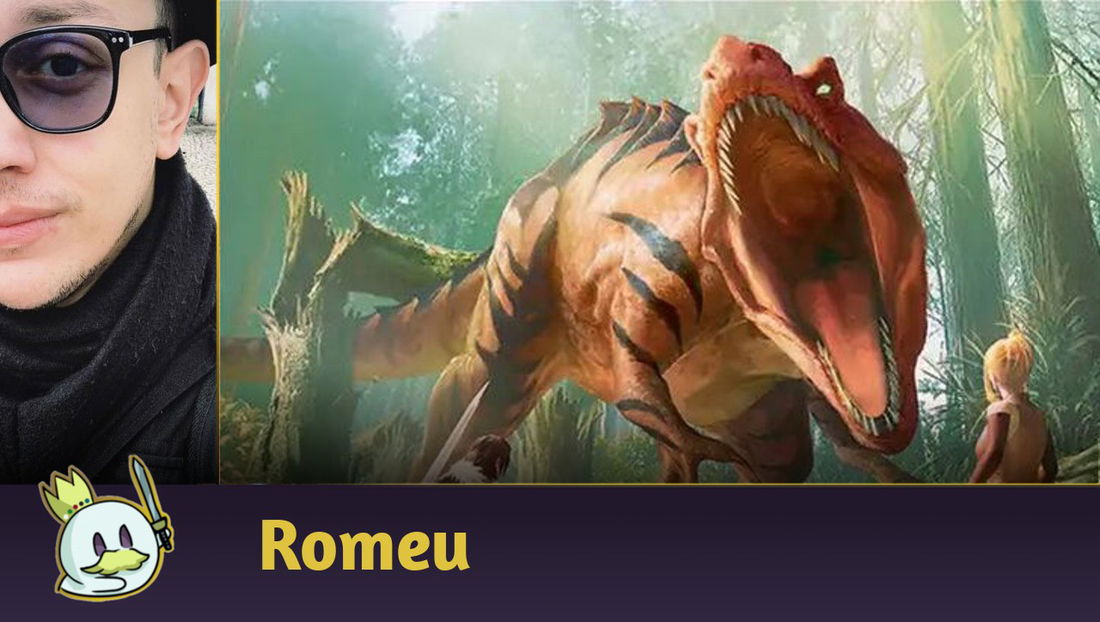Intro
Hey there, how's it going? The long-awaited time has come: it's Final Fantasy in Magic!
One of the greatest video game franchises comes to Magic, and also brings some changes. It's the first time that a Universes Beyond set will be valid in all sanctioned formats.
In this article, we'll cover everything you need to know to play the set's limited, with a main focus on the pre-release events that will take place on June 6th. So, we'll talk about mechanics, archetypes, mana fixing, and removals!
Final Fantasy
In Final Fantasy, we have a few returning mechanics, some new ones, and also some twists on existing mechanics.
Let's start by looking at some of the set's main mechanics, but if you want a more in-depth look, we have an excellent article focused on them.
Mechanics
Job Select
Job Select is a variation of Living Weapon, and is a good way to improve the value of equipments, reducing the need to balance the number of creatures and equipment in their respective archetypes.

Tiered
Tiered is a way to increase the effects of a spell according to your available mana, which is very interesting in Limited. All Tiered spells in the set are instants.

Sagas
In sagas, we have the innovation of creature sagas, which means you lose the creature after the last chapter in the saga resolves. This is something we need to be very aware of.

Adventure/Town
All Adventure cards in the set are Town-type lands. Remember that if the adventure is countered for any reason, it will go to the graveyard.

Transform
In the set we also have cards that transform to their other side after meeting some requirement, which means the cards have more possible gameplay options.

Landfall
We have Landfall returning, a very significant strategy in Limited, since our land availability is key to the game's development.

Final Fantasy: Through the Ages
Within the set, we have the possibility of finding cards from Final Fantasy: Through the Ages, which can greatly synergize with the available archetypes.
Final Fantasy Limited Archetypes
Azorius Artifacts


The blue and white strategy is an artifact-matters one, with a great focus on building a specific setup.
Tidus, Blitzball Star is extremely important in the archetype, gaining power as we play the game. Another good focus is Cid, Timeless Artificer, which strenghtens your vehicles, artifact creatures and Heroes. We can also use other artificers, such as Edgar, King of Figaro, which provides us card advantage, or Terra Branford (Urza, Lord High Artificer), which will help the archetype both with mana availability and put a significant body on the battlefield.
In both cases, we will need good artifacts. For this, we'll use equipments with the Job Select ability. Machinist's Arsenal has great potential in the archetype, being able to close out games from nowhere.
Magitek Armor and Magitek Infantry are very good for board development.
White Auracite works as a removal and mana rock, advancing our gameplan.
Absolute Virtue, despite being an incredible card, has a very high cost and needs to be protected so that we can guarantee a victory with it. If you're able to ramp up and protect it, it wins the game by itself.
Firion, Swordmaster // Sram, Senior Edificer works very well with vehicles and equipments, being an interesting option for the archetype.

Best Commons

Best Uncommons

Orzhov Sacrifice


In Orzhov colors, we have a sacrifice-focused archetype, on creatures and artifacts. Therefore, we want cards that have a bonus when these types are destroyed or leave the field. Judge Magister Gabranth gains power when you sacrifice things. G’raha Tia is a way to replace cards that we sacrificed, but the high mana cost hinders its use in the archetype. Al Bhed Salvagers is an excellent way to accumulate damage on the opponent while we keep the engine running.
We also need cards to feed the archetype; mostly cards that have an effect when they are destroyed. Aerith Gainsborough and Dwarven Castle Guard are some examples, the latter providing another body to feed the sacrifices. Squall, SeeD Mercenary is a way to bring back resources and Rufus Shinra allows us to have a constant way to sacrifice things.
Now, to finish the setup, we need sac outlets in order to jumpstart the archetype. Cards like Vayne’s Treachery and Phantom Train. Ahriman is one of the best, since we can recover the sacrificed resources.
Baron Rivalry (Deadly Dispute) replaces cards, activates the archetype and also advances and fixes our mana, making it an excellent option.
Sephiroth, Fabled SOLDIER is another excellent card, checking several tick boxes at the same time.
The Emperor, Hell Tyrant // Yawgmoth, Thran Physician does everything the archetype wants: controls the opponent's board, sacrifices creatures, draws cards. It is the best card available for the archetype.

Best Commons

Best Uncommons

Boros Aggro Equipments


In red and white, we have an archetype focused on equipment, aiming to pressure the opponent from the beginning; to do this, we will use low-cost creatures that interact with equipment. Look for equipments with Job Select, in order to maintain board presence. Adelbert Steiner is an aggressive option, becoming more efficient with each piece of equipment we put on the field.
Cloud, Midgar Mercenary in addition to searching for equipment, can enhance their abilities, such as when we combine it with Buster Sword, triggering it twice. Machinist’s Arsenal combined with the other pieces of equipment turns any creature into a big threat.
Weapons Vendor is a way to bypass the equip cost, easening the archetype's mana.
Firion, Wild Rose Warrior provides haste to our equipped creatures, allowing Job Selected equipment to enter the battlefield and attack right away, in addition to creating copies that last until the end of the turn, improving our combat options. Giott, King of the Dwarves is excellent for cycling our hand and finding what we need in the game.
Raubahn, Bull of Ala Mhigo allows us to bypass equip costs, when combined with equipment such as Ultima Weapon and Aettir and Priwen, which have very high costs.
Joshua, Phoenix's Dominant is a good way to refuel in longer games, activating its transformation ability. When it enters the battlefield, it helps us by discarding useless cards and search for what we need.
Zidane, Tantalus Thief is a way to remove a problematic blocker, and it can push damage through to close out a game.
Genji Glove is an interesting equipment; the combination of double strike and extra combat is quite exploitable.
Excalibur II can work together with a lifegain strategy, reaching a setup where the equipped creature becomes increasingly stronger.
Creatures with evasion are very welcome, as well as equipment that provides evasion. Dragoon's Lance serves as an example, allowing each creature to be a potential threat, when combined with equipment to close out the game.
Best Commons

Best Uncommons

Selesnya Tokens


In white and green colors, we have the go-wide archetype. There is not much room for variation, we will look for creatures that make tokens and thus increase the board, and use spells that strengthen all of our creatures at once.
Rinoa Heartilly is an example, 2 bodies in 1 card, and a triggered ability that strengthens another creature. Dion, Bahamut’s Dominant, Magitek Armor, Aerith Rescue Mission, Moogles’ Valor, Chocobo Racetrack are the types of cards we want to develop our game.
Quina, Qu Gourmet enhances the archetype, making extra tokens.
Summon: Fat Chocobo combined with Garnet, Princess of Alexandria allows us to reuse the chapter that creates tokens, growing our board with each attack.
Serah Farron is another interesting card, since it allows us to cast bigger spells by reducing the costs of legendary creatures.
Princess Sarah (Azusa, Lost but Seeking) allows us to synergize with landfall, being especially efficient combined with Traveling Chocobo, since the Bird tokens will deal more damage.
Sidequest: Raise a Chocobo, if we can transform it, will dominate a board.
Yuna, Hope of Spira allows us to go for a gameplan with the sagas, generating value and bringing them back after finishing. Summon: Fenrir, Summon: Titan and Summon: Primal Garuda are some options.
Ambrosia Whiteheart is a way to take advantage of returning sagas or creatures that have an enter-the-battlefield effect, using their abilities again.
Snow Villiers is an option that takes advantage of the archetype, becoming a significant threat.
Once the battlefield is populated, let's move on to how to close out the game:
Rydia's Return and Auron's Inspiration are good options to increase the power of creatures in combat.
Aerith Rescue Mission is also a great way to deal with pesky blockers, getting them out of the way and unbalancing the fight.
You’re Not Alone is a very interesting combat trick that can finish games out of nowhere with its significant damage increase.
Tifa’s Limit Break can be another combat trick option, working very well on creatures that already have their power increased.

Best Commons

Best Uncommons

Dimir Control


In blue and black combination, we have a focus on controlling the opponent's actions and presenting a significant threat.
To do this, we want removals and creatures that have bonuses when the opponent's creatures die or that provide us cards selection or advantage.
Locke Cole is a way to adjust our hand, guaranteeing land drops, finding the necessary removal and gaining some life. Deathtouch also helps, preventing opponents from being able to attack freely.
Vincent Valentine has an ability that, if well combined with our removals, will cause considerable shift in life totals due to lifelink, considering his transformation.
Zenos yae Galvus is an interesting option against decks with many creatures, being able to kill them with his ability when entering the battlefield. After transforming, he becomes a significant threat that, with a few attacks, will finish the game.
Vayne's Treachery is a good low-cost removal that is extremely effective when paired with Undercity Dire Rat to advance our mana.
Sidequest: Hunt the Mark is another interesting card: it deals with the opponent's threat and allows us to advance our mana through treasure creation.
Overkill is a definitive removal that deals with indestructible creatures, very efficient and with a good cost.
Matoya, Archon Elder combined with Il Mheg Pixie, Ultimecia, Time Sorceress or Golbez, Crystal Collector provides card advantage.
Travel the Overworld is a way to replenish our hand after some trades.
Summon: Primal Odin is an option to close out games, being possible to combine with Jill, Shiva's Dominant, which when transformed can make a creature unblockable. Although it is very difficult for this synergy to happen because they are both rare cards, it is important to keep the possibility in mind.
Jecht, Reluctant Guardian allows us to have a more midrange game plan, being more aggressive and attacking the opponent's hand. It is a viable alternative to the archetype's strategy.
Thief's Knife combined with creatures with flying are a way to maintain our resources and connect some damage while our other creatures control the board.
Battle at the Big Bridge (Fatal Push) is an excellent removal, being easy to activate revolt and deal with larger creatures.
The Shadow Lord (Gix, Yawgmoth Praetor) is another option to maintain the necessary card advantage to run the archetype.

Best Commons

Best Uncommons

Izzet Big Noncreature


In the Izzet combination, we have an archetype focused on non-creature spells that cost 4 or more. So, to build this archetype, we will need permanents that trigger effects that meet the requirements.
Shantotto, Tactician Magician, in addition to accumulating damage, gives us card advantage for the archetype, while Prompto Argentum increases our mana.
The Emperor of Palamecia helps to generate mana for spells and strengthens itself in the process, managing to connect good damage at the end of the game.
Tellah, Great Sage allows us to grow the board and draw cards, also finishing the game if we invest 8+ mana for a spell, since it will deal a ton of damage.
Vivi Ornitier can accumulate damage while strengthening itself with counters, enhancing its mana generation in the process. One of the best cards for the archetype.
Ultros, Obnoxious Octopus is a tempo tool, putting stun counters on opponent's creatures.
Queen Brahne creates Wizard tokens when attacks. Prowess enables good attacks even against larger blockers, making more tokens and letting the opponent decide whether to risk it or not, after all, combat tricks are excellent with prowess creatures.
Summon: Esper Ramuh is interesting, and with some spells in the graveyard it can be an excellent removal.
Astrologian’s Planisphere, besides being a non-creature spell, is capable of making any creature a sizeable threat.
Sahagin can be a way to get past blockers and connect damage. Combined with Thief’s Knife it allows you to find resources to continue dealing damage.
An important caveat of the set is the equipment with Job Select, allowing you to use the equipment to make creatures and fulfill both roles needed for the archetype.
Quistis Trepe allows us to reuse a spell, mainly card draws or removals.
Summon: G.F. Cerberus allows us to maximize the usage of instants/sorceries, and when combining with Sorceress’s Schemes can replenish our resources.
Thrum of the Vestige (Lightning Bolt) is one of the best removals available, period.
Zidane Tribal (Ragavan, Nimble Pilferer) is an aggressive early game option, capable of advancing mana at the beginning of the game, in addition to using the opponent's cards if it connects.

Best Commons

Best Uncommons

Simic Town Ramp


In the blue and green combination, we have an archetype that cares about Town-type lands, with a focus on significantly ramping up our mana.
To do this, we use cards like Ignis Scientia, which allows us to increase mana and have a body on the battlefield. Summon: Fenrir is another similar option that helps our strategy.
Goobbue Gardener is another way to accelerate our game.
Chocobo Racetrack is interesting, since we intend to increase our land availability, being a way to increase our board.
Sazh Katzroy is a way to strengthen our board and guarantee land drops, taking even more lands from our deck and, therefore, improving our draws.
Reach the Horizon allows us to search for towns, allowing us to choose options that adjust our mana curve such as Crossroads Village, Starting Town, Guadosalam, Farplane Gateway, or with abilities Adventurer’s Inn, Clive’s Hideaway, Eden, Seat of the Sanctum and The Gold Saucer.
Princess Sarah (Azusa, Lost but Seeking) is a way to greatly accelerate our land drops, although it needs for us to have lands in hand.
Seymour Guado (Kinnan, Bonder Prodigy) is an excellent option for ramping, doubling our mana, so we can play 6-cost creatures on turn 3 just because he's on the board.
With the ramp setup complete, we'll play big spells to win the game. Omega, Heartless Evolution locks down the opponent's board, recovers life and presents a significant body, being one of the best spells to use in this phase of the game.
Summon: Titan is another good option, with a final chapter that turns any creature into a great threat.
Jumbo Cactuar only needs trample to finish games.
Summon: Leviathan is a good option for late game.
Travel the Overworld is another excellent option to replenish the resources spent on ramps and find creatures to close out the game.
An alternative way to play is to use the Summoner's Grimoire equipment, allowing us to advance our game by playing our creatures without paying their cost.
Options such as Summon: Bahamut and Ancient Adamantoise are very welcome in conjunction with the equipment.
Astral Titan (Primeval Titan) is another good option to put on the field with the equipment, and it helps to improve our draws by taking lands from the deck.
Balamb T-Rexaur and Ice Flan are good ways to guarantee land drops and have endgame threats, so don't be afraid to cycle to look for lands.

Best Commons

Best Uncommons

Rakdos Black Mage Aggro


In the black and red combination, we have an archetype that aims to cause direct damage when casting non-creature spells.
Therefore, we need creatures that have this ability or to create 0/1 Wizard Tokens that have this ability.
Kuja, Genome Sorcerer in addition to creating tokens, once transformed it increases the damage.
Black Waltz No. 3 is a way to increase damage, since in addition to evasion, the static ability can accumulate a lot of damage on the opponent even if the creatures on the battlefield aren't attacking.
Queen Brahne is a good way to increase the token count, and with prowess she will prevent the opponent from making good blocks.
Black Mage’s Rod is what I consider a key card for the archetype, as it activates the tokens’ effect and provides the same ability to the equipped creature, allowing the effect to continue even on other creatures.
Circle of Power replenishes our hand, makes more tokens, gives lifelink and increases the power of our mages.
Cornered by Black Mages is another card that does a lot for the archetype, taking away the opponent's creature, activating token abilities, and making more bodies.
Red Mage’s Rapier is an alternative to accumulate damage in combat, becoming especially efficient on creatures with evasion.
Dark Confidant is a very interesting card in the deck, but we must build the deck taking care with the costs so as not to die to it.
Choco-Comet is a way to deal with creatures and finish games, in addition to creating a body on the field.
Laughing Mad is an option to cycle cards and the flashback is essential when you need to cast another spell.
Haste Magic in addition to the combat trick allows us to gain advantage through the exiled card.
Sorceress’s Schemes is a way to reuse spells.
Other good cards in the archetype are Thrum of the Vestige (Lightning Bolt) and Battle at the Big Bridge (Fatal Push), which are excellent removals.
Promise Fulfilled (Light Up the Stage) increases our resources, working very well in the archetype due to its spectacle cost.
Zidane Tribal (Ragavan, Nimble Pilferer) is excellent in a vacuum, increasing the availability of spells if your opponent has them, and creating treasures.
Another way to play the archetype is through equipments with Job Select, which will trigger the spellcasters' abilities and increase our board.

Best Commons

Best Uncommons

Golgari Graveyard


In the black and green combination, we have an archetype that cares about cards in the graveyard. We use creatures that care about the graveyard or that feed it.
Town Greeter in addition to feeding the graveyard, helps us search for lands.
Shinra Reinforcements is another way to feed the graveyard.
Vanille, Cheerful l'Cie in addition to returning a permanent, can merge with Fang, Fearless l'Cie to generate Ragnarok, Divine Deliverance.
Cloud of Darkness can be an excellent removal with a good early game setup.
Exdeath, Void Warlock is a good body, gaining considerable life. Once transformed, it has the ability to be decisive if it stays on the board.
Diamond Weapon is a card that we can play very early. It doesn't die in combat and forces the opponent to have a direct removal. For me, one of the best cards of the archetype.
Evil Reawakened is a way to bring higher cost creatures from the graveyard to the battlefield, being especially interesting in self-mill strategies.
Following this strategy, Malboro and Balamb T-Rexaur are excellent, they guarantee land drops and go to the graveyard by themselves.
Another interesting creature for this strategy is Summon:Bahamut. With many effects from the saga, it is very unlikely that it will not be able to finish the game.
For this strategy, Ninja’s Blades is a way to discard any cards that we'll reanimate afterwards.
Ardyn, the Usurper is another interesting creature to be reanimated; its ability allows good attacks while controlling the opponent’s graveyard, and if there is a lack of creatures, our own graveyard can be used to make more demons.
Another way to play the archetype is a more midrange approach, taking advantage of graveyard interactions. This way, we use early game creatures to trade with our opponent and try to have an advantage with cards that care about the graveyard.
Gaius van Baelsar, which will feed the graveyard and deal with something from the opponent, Hecteyes, which attacks the opponent's hand, and also enhance Vayne's Treachery.
Undercity Dire Rat trades in the early game and help us to ramp.
Goobbue Gardener speeds up our plays and allow us to double spell.

Best Commons

Best Uncommons

Gruul Landfall Aggro


In the red and green combination, we have an aggro archetype that synergizes with landfall. We use low-cost creatures and cards that return lands to our hand.
For the Landfall strategy, we have spells that make Bird creatures such as Gysahl Greens, Sidequest: Raise a Chocobo, Summon: Fat Chocobo, Call the Mountain Chocobo, Choco-Comet and Chocobo Racetrack. The tokens gain +1/+0 for each land that enters the battlefield until the end of the turn.
Our strategy is to develop the board with these tokens, using some support cards such as Bartz and Boko, which will function as removal.
Traveling Chocobo will enhance all of our creatures' triggers. Sazh’s Chocobo is a very aggressive option for the first turn, being able to grow significantly, especially with Traveling Chocobo on the field.
Sazh Katzroy is a way to tutor what we need, being particularly strong with Sazh’s Chocobo, which would already have 3 counters, going to 4 before doubling to 8 (yes, it is a potential 8/9 on turn 4, if there is no removal).
Sabotender is another option to accumulate damage on the opponent with lands.
One of the main supports of the archetype is Zell Dincht, which allows us to play more lands in the same turn, and returns a land to our hand at the end of the turn, ensuring that we always have lands to activate landfall.
Ride the Shoopuf is another way to enhance the archetype, strengthening the board and, in the endgame, with the excess lands, it becomes a 7/7.
Tifa Lockhart is also an interesting card within the archetype. If we can apply a combat trick to increase its power, landfall can be crucial to deal a lot of damage and quickly finish some games.
Cactuar is a very aggressive creature, allowing us to connect 3 damage in the second turn. However, its return-to-hand effect is somewhat problematic, mainly because it has no haste.
Chocobo Kick is an excellent removal for the archetype. With the kicker cost of returning land, we can activate landfall to apply more damage and also remove a creature.
Within the colors, we can follow other paths, such as Rydia, Summoner of Mist, which focuses on saga creatures, or Gladiolus Amicitia, which would be in a strategy more focused on ramping to cast heavy spells.
Balthier and Fran are Commander cards. In the set, we don't have vehicles in the same color pair, making it very inefficient in green and red. Obviously, this changes if we can use blue and white efficiently.
Zidane Tribal (Ragavan, Nimble Pilferer) is an extremely strong piece in any aggro archetype, so there's no reason not to include him, and he can be a game-changer if played on the first turn.
Thrum of the Vestige (Lightning Bolt) is the best red removal available. A Promise Fulfilled (Light Up the Stage) in the aggressive archetype is perfect for gaining value at a low cost.
Princess Sarah (Azusa, Lost but Seeking) has good potential with Landfall abilities, allowing us to hold lands and play them all at once in a single turn.

Best Commons

Best Uncommons

Removals
Removals are very relevant in Limited, so we'll address the main ones in each color.
Colorless

Lion Heart is obviously inefficient due to its cost, but in sealed, removals are a must, even if overcosted. In addition, it can cause direct damage to the player, ending games.
With these considerations, it is still effective against 34.48% of the creatures in the set.
Lunatic Pandora is an interesting artifact that allows you to control the top of the deck and feed the graveyard. It can be an alternative for decks with this interaction and, in the future, a removal.
White


In white, we have Battle Menu as a versatile spell, suitable for any moment.
Fate of the Sun-Cryst is a catch-all nonland removal, and can deal with several different permanents. The high cost is a negative, but tolerable due to its versatility.
Slash of Light is excellent for decks with a lot of board presence.
Summon: Primal Garuda has the interesting point of being a saga creature, with subsequent effects and a body on the board.
White Auracite is a classic removal for white, which normally costs 3 mana, like Banishing Light. The extra mana in exchange for another mana source is very interesting, especially in archetypes that need to ramp.
Stroke of Midnight is represented by Memories of Nibelheim.
Finally, we have Ultima as the set's "wrath". I personally don't like its design, although it is very efficient in the set, taking out all the artifacts. The fact that it ends the turn prevents the player who used the global from having any initiative afterwards.
Blue


In blue, the main innovation is Ice Magic, which, depending on the amount of mana used, can be a strong removal or a tempo play.
Stuck in Summoner’s Sanctum is an option to deal with a creature or artifact that have a problematic ability.
Black


Speaking of the main black removal spells, Overkill is the best one in the set, dealing with even indestructible creatures.
Vayne’s Treachery is very efficient, especially in sacrifice archetypes, hitting 94.83% of the set for just 2 mana.
Zenos yae Galvus works as a global, dealing with 34.48% of the creatures in the set, while Poison the Waters reaches 12.64%.
Another removal option that I found very interesting is Gaius van Baelsar, since it can remove enchantments or force removal from the opponent, activating your sacrifice.
Red


For red, let's highlight Choco-Comet, an interesting removal option that still leaves a body on the field.
Self-Destruct can deal with a problematic creature from the opponent or be used to finish the game, with a burn directly to the face.
Suplex is an alternative version of Abrade, but at sorcery speed.
Fire Magic and Thunder Magic are very versatile, but their costs after the first tier are a little high. They become effective in later turns since you have more mana available.
Thunder Magic has a range of 34.48%, 81.03% and 98.85%, while Fire Magic has its highest range at 59.20%.
Green


In green, we have a variation on Chocobo Kick, allowing you to double the damage done in exchange for returning a land, which works very well with Landfall.
In Clash of the Eikons, we have the possibility to advance or rewind the chapters on a saga, which is very interesting within the set.
Mana Fixing
There are a lot of ways to generate colored mana in the set, being through treasures, mana filtering or dual lands. Let's check out some of these options.
Artifacts

Among the artifacts, most generate a ramp, not a filter. World Map is a way to correct land drops, while Crystal of Altar Cave (Chromatic Lantern) allows lands to generate mana of any color, being the most efficient fixing of all.
Lands
Among the lands, we have many dual Town lands, which correct our mana well, and some lands like Capital City, which filters our mana, Crossroads Village, where we choose the color when it enters the battlefield, and Starting Town, which works like a pain land to generate any color.
Conclusion
The set is very interesting, the abilities are vast and I imagine that fans will really like the art, which is incredible!
The cards from Through the Ages have the potential to be very relevant in Limited, but I imagine that they won't be easy to find.
Battle at the Big Bridge (Fatal Push) and Thrum of the Vestige (Lightning Bolt) are the easiest to fit, in my opinion, as well as Zidane Tribal (Ragavan, Nimble Pilferer), which will play in any deck that has red.
The Emperor, Hell Tyrant (Yawgmoth, Thran Physician), Hero of Light (Adeline, Resplendent Cathar), Terra Branford (Urza, Lord High Artificer) and Astral Titan (Primeval Titan) and Seymour Gado (Kinnan, Bonder Prodigy) are the strongest cards within their archetypes.
Which archetype seemed the most interesting to you?

For me, the most interesting one is Rakdos. The game plan interacting with equipment seems very solid to me. But, if I have the pieces, I'll do Gruul Landfall with the no-flying birds!
For any questions or suggestions, remember to leave a comment below.
See you in the next article. Cheers!













— Comments 0
, Reactions 1
Be the first to comment